My Experience Climbing Mount Hood
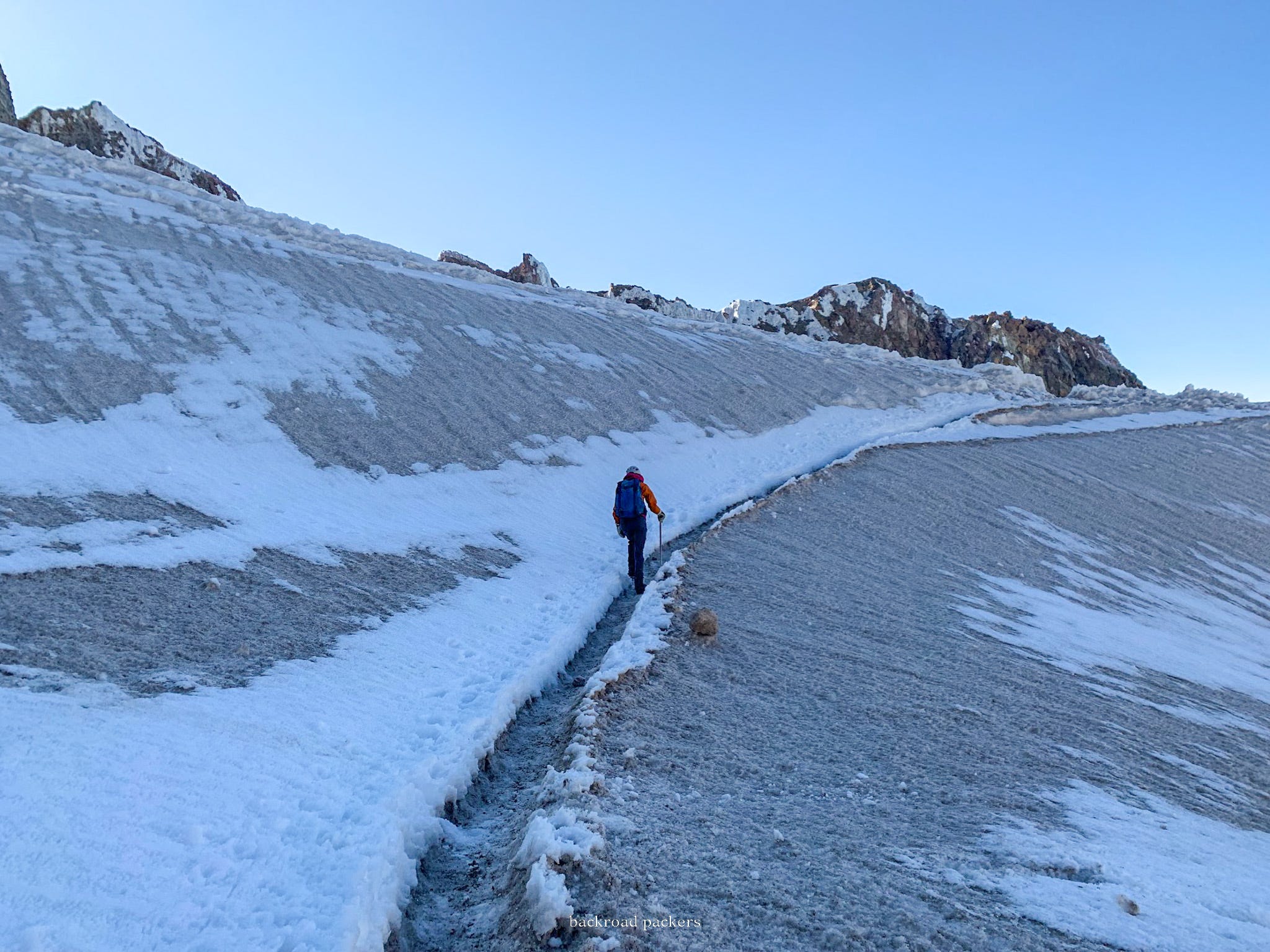
Upon moving to Oregon, I knew I had to summit Mount Hood — or at least attempt to. But the thing was, while I had recently taken a mountaineering course down in South America, I hadn’t spent much time on big, glaciated peaks in the USA. I felt like that needed to change.
So after one failed attempt due to white-out and miserably wet conditions, I once again found myself at the start of the trail looking up at Hood during a clear, balmy 50° midnight start.
Below is an outline of my own experience climbing and summiting Mount Hood, the highest peak in Oregon and the second most climbed glaciated peak in the world (after Mount Fuji in Japan). Hopefully, this gives you a good idea of what to expect if you are looking to mountaineer Mount Hood yourself.
► Explore my in-depth planning guide to summiting Mount Hood here.
SUMMITING MT. HOOD (SOUTH SIDE) | THE ADVENTURE BREAKDOWN
MOUNT HOOD ROUTE MAP (SOUTH SIDE)
Below are two maps outlining the southern route(s) up to the summit of Mount Hood. I went up the South Side Approach to the right of Crater Rock and then took the alternate route across and up Old Chute (before actually taking the 1 O’clock Couloir) to the summit.
On the way down, I kept going all the way down to Fire Rocks (Route 5) instead of taking the alternate crossing. Then it was to the left of Crater Rock and down the same South Side Approach. You can read more about this below.
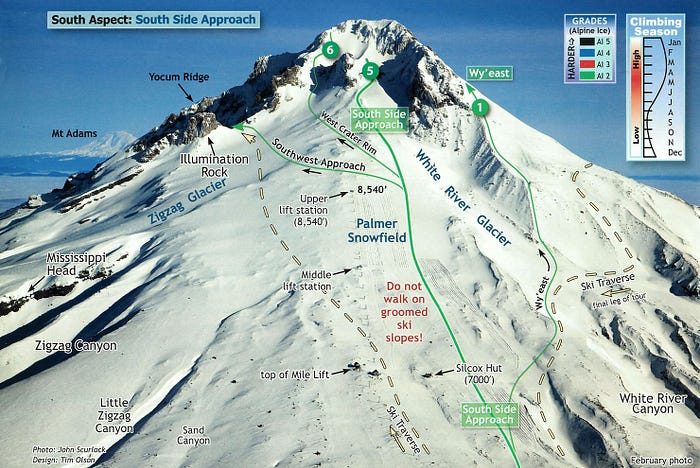
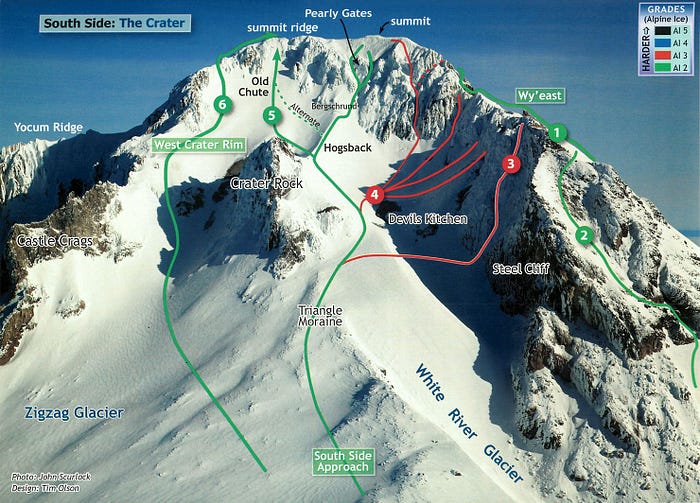
Photo Credit (both): Mt Hood Climber’s Guide by Bill Mullee and Wanderlust Hiker
TIMELINE OF MY MOUNT HOOD SUMMIT HIKE
Started Hiking | Midnight
I camped at the trailhead the night before.
Reached Silcox Hut on the ski resort | 1AM
Reached the Top of Palmer Lift | 2AM
Got Right Below Crater Rock | 3:30AM
Put on my crampons right after the top of Palmer Lift, though I ended up taking them off a bit later once I reached a clear trail on rock and dirt. But I did put them back on once I got to the snowfield right below Crater Rock.
Start of Hogsback | 4:30 AM
My group took an hour break at the base of the Hogsback to wait for the sun to rise and to let the clouds on the summit clear out.
Summit | 6:15AM
The final push up the steep section took around 30 minutes, though I was lucky to not have to worry about other groups going up or down. I ended up staying at the summit for about 15 minutes — just long enough to take some photos, eat a victory sandwich and take in the amazing view.
Base of the Hogsback on the Way Down | 7:30AM
Fortunately, I only had to wait for one group of 6 to climb up when I headed back down the 1 O’clock Couloir.
Halfway Down Palmer Lift | 9:55AM
I tried glissading as much as possible but the snow was pretty meh.
Finished | 10:30AM
Made it back to the trailhead roughly 10.5 hours after starting out. Long morning but so, so worth it. Promptly changed out of my mountaineering boots and grabbed a coffee.
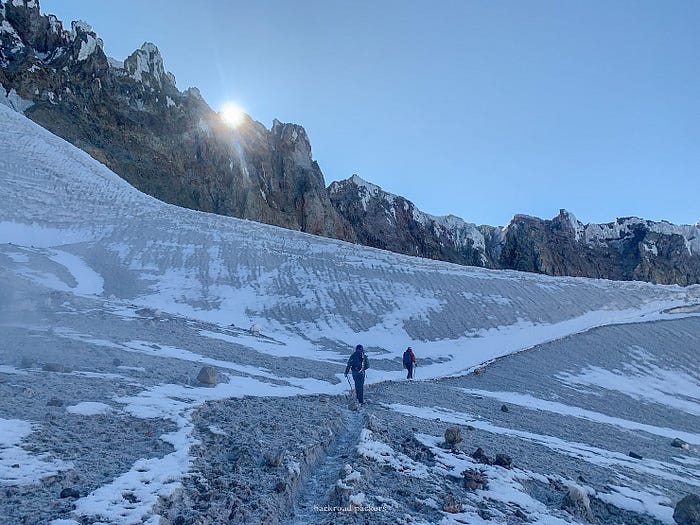
THREE THINGS TO DO BEFORE STARTING YOUR HIKE UP MOUNT HOOD
| Check the weather regularly, including the morning of your planned summit push. This is very important because bad weather can really make or break this climb. Here is a great site to check.
| Fill out your climbing permit. You will need to do this at the Climber Registration Office in the ski resort lodge (here). Fill in all the information and then keep the visitor copy on you when out climbing.
| Make sure you have ALL of the necessary gear; including most importantly a helmet, crampons, ice axe, and a headlamp (or two just to be safe).
\\ Route Guide to Summiting Mount Hood Via the South Side
TOTAL DISTANCE: 6.4 miles // 10.3 kilometers
ELEVATION PROFILE: 5,249 feet // 1,600 meters
TIME NEEDED: between 5 and 7 hours to summit, half that to get back down
TRAIL CONDITIONS: relatively straightforward hike for the first 90% of it (especially if you have a map with you), the last 10% up the Hogsback and through either Old Chute or 1 O’clock Couloir is intense. Bring proper mountaineering gear for the summit push.
START | Try to start really early — we’re talking like midnight or 1AM. I met someone who started at 11:30PM. While it sucks getting up that early, it will be worth it once you reach the danger zone below the summit and are rewarded with good snow conditions and amazing sunrise views.
1 | From the parking lot, head up the dirt trail toward the ski lift. It will be dark out but the first mile or so is pretty easy to follow since it is on a wide, dirt road. Keep going up this until you reach the ski lift.
2 | At the 1-mile mark you will get to the Silcox Hut, a large wooden building at the point where the first ski lift (Magic Mile) ends and the Palmer Lift begins. This is a decent spot to take a quick break if necessary. Otherwise, keep heading up (and up and up).
❔GOOD TO KNOW: the hike is pretty much uphill from the start. Between the parking lot and where you get to the Palmer Lift/Silcox Hut, the grade hovers between 16% and 26%. Once past this point, it gets a bit steeper (staying in the mid-20%) until you eventually get to the Palmer Glacier — from there it is 30% or more.
3 | You will reach the start of the Palmer Glacier at 1.6 miles. It does get a fair bit steeper from here on out so this could be a feasible spot to put on your crampons. I ended up waiting until the 2-mile mark (right at the point the lift ends), though there were definitely parts where the steepness was a bit tough in just normal mountaineering boots.
The end of the Palmer Lift is another good spot to take a break. There is a road that cuts across and if the sky is clear you should be able to start seeing city lights down and around you. Also, be prepared to be blinded by snowcat lights while hiking up this part. For some reason the ski resort has the cats out grooming between 1 and 2AM.
4 | Depending on the time of year you are mountaineering Mount Hood, after the lift you will either be on snow the rest of the way or be able to hike on a decent amount of rock. I did it in mid-June and was able to somewhat easily follow a trail up a rocky ridge. To get on the trail/ridge, head straight up towards Crater Rock (check your map for this). You should be able to see that there is a dirt/rock section that cuts between Zigzag Glacier and White River Glacier. This is the ridge.
💬 INSIDER TIP: though I did put my crampons on right at the end of the lift, I ended up taking them off soon after once I realized the rock and dirt ridge line was faster. I would say that if you are looking to summit later in the season when a lot of the snow is gone, you can probably get close to the Devils Kitchen without putting your crampons on (but obviously do what feels best for you!).
5 | Keep hiking up the ridgeline. During this section of the hike the grade hovers between 34% and 42%. Take your time and try to just keep a steady pace.
6 | Once you get around Crater Rock you will be to the left of Devils Kitchen and on the Coalman Glacier. Keep an eye out for large crevasses around you (there are multiple) as well as fumaroles. The Hogsback is a clear trail going up a ridge right below the summit point. This part of the trail is steep, but there will likely be steps kicked in (obviously don’t count on this for mountain conditions are always changing).
❔GOOD TO KNOW: I went up the Hogsback on my way up but was told to instead head towards Fire Rocks (the fumarole section to the left of the trail) on the way down by one of the mountain guides my group ran into. There is a clear trail for both options so take your pick. The Hogsback is steep but if you go slow and use your crampons and ice axe you should be fine. But from the top of the ridge you will need to cut left across a steep face that does have crevasses above and below. Again if you take your time and stay calm you should be fine. BUT, it is a bit dangerous since rock falls do often occur here. The other route gets rid of that somewhat sketchy crossing and instead goes up right below the Old Chute section. Take your pick depending on what you feel more comfortable with.
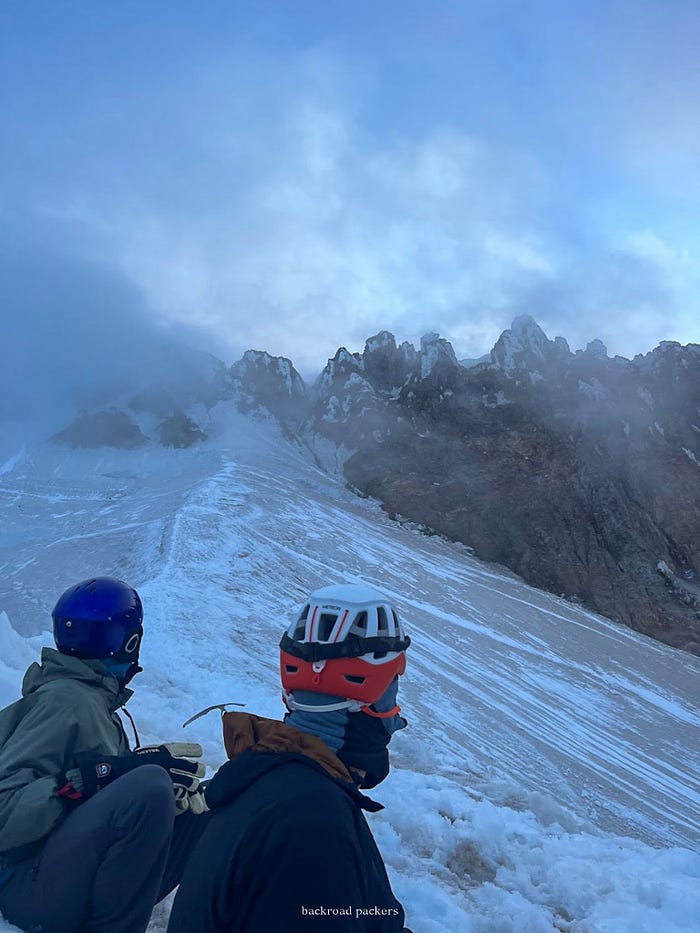
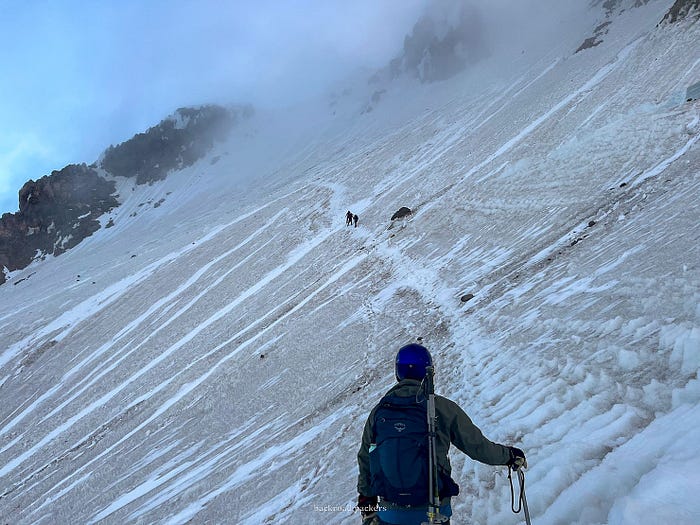
7 | Once on the base of the final climb, it can be a bit nerve-wracking to look up at what you have to do next: climb a very steep and icy snowfield that has clearly been hit with falling rock. Add on extra people and it can seem like a bad idea. But trust me — it is not as bad as it looks (promise!).
Like with everything else, take your time, make sure all of your steps are firm, trust your gear and just keep moving up. I tend to do a bit of a crisscross maneuver: take a few steps to the right and then cut to my left. Always keep an eye out above you just in case rocks fall from the nearby ridges or if a mountaineerer above you kicks off some ice.
8 | The final bit can either be done via the Old Chute (to the left of the final face) or up 1 O’clock Couloir, which is a tight section on the right side. I unknowingly went up the latter and while the last 10 yards were a bit intense (80+% grade and icy) by focusing on my ice axe placement and making sure my feet were always on firm ground before stepping up (and just not looking back down), I got up and over the top without any issues.
❔GOOD TO KNOW: if you go up Old Chute you will have to cross a section known as the Catwalk. Depending on the time of year you summit, this can be quite exposed.
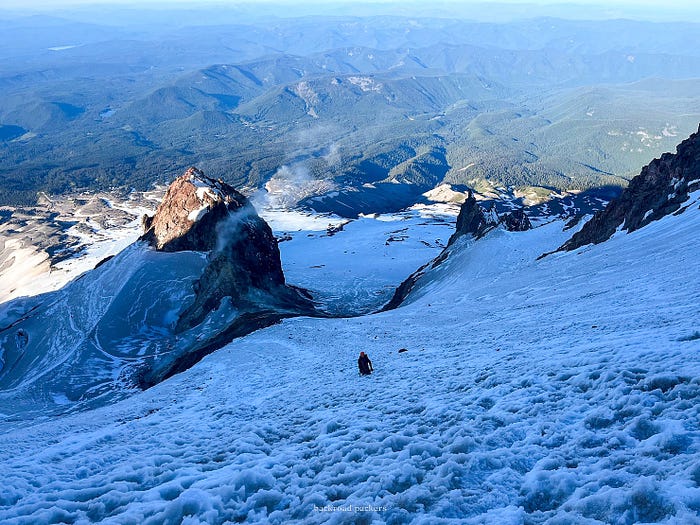
9 | Once you get up the last tricky section — by far the most intimidating part of the whole summit push — you will be rewarded with amazing views of the surrounding peaks and valleys. There is a short ~2 minute hike to the actual summit, which is actually in front of you (there will likely be a trail cut into the snow). You will know you reached the official summit when you see the marker.
On a clear day, you will be able to see Mount Saint Helens, Mount Adams, and Mount Rainier to the north and Mount Jefferson and the Three Sisters to the south.
Congratulations, you just summited the highest point in Oregon!
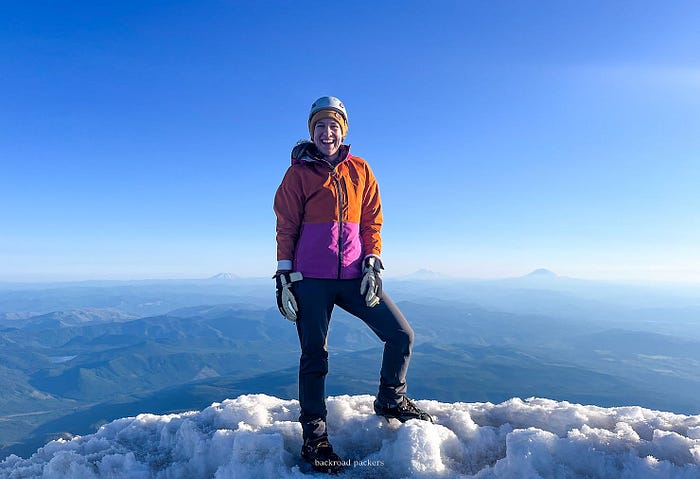
10 | Once you get your fill of the summit, eat a victory sandwich and snap a few photos, start to make your way back over to the point where you came up (either the couloir or the chute). More likely than not, you will need to wait a bit to allow other climbers to come up before you head down (traffic jams are common even here on the mountain). Be a responsible mountaineerer and give the uphill climbers the right of way.
11 | Take your time heading back down the steep section: sometimes going down can be even more dangerous and nerve-wracking than going up. Keep your ice axe handy and watch out for others. Some people choose to go down backward, though I like to go down facing forward. Toward the end of this section you can (if comfortable) simply duck-walk down.
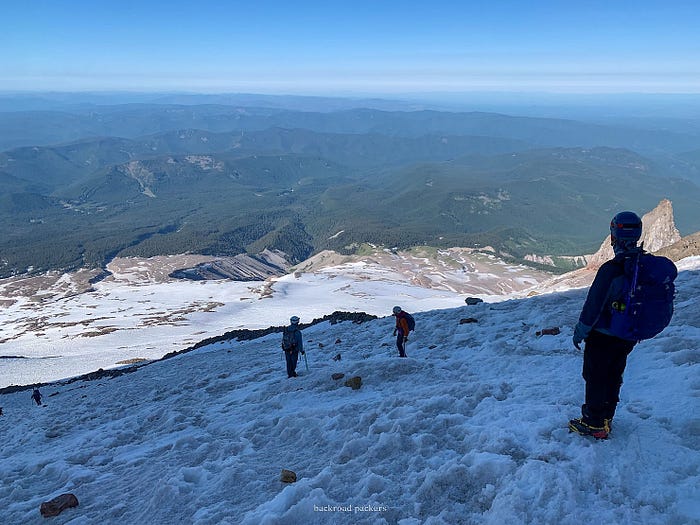
12 | Choose whether to cross over to the Hogsback or head straight down toward Fire Rocks. Either way you choose you will want to meet back up with the same trail you came up at Devils Kitchen. By now the sun should be up and it will be easier to follow the ridge trail or walk down the glacier/snow. Once you reach the rocky ridge, you can take your crampons off. Though consider leaving your helmet on just in case.
💬 INSIDER TIP: in the upper part I found the ridge to be faster to get down, but once the steepness decreased a bit I ended up heading out on the snow and trying to glissade. If you want to glissade, make sure to take your crampons off.
13 | Once you make it back to the ski resort boundary you will need to head to the left and follow signs for the “Climbers Trail.” This will bypass the resort and follow a groomed road back down to the parking lot.
Honestly, by this part of the hike I was pretty done with my boots and was so ready to put on new clothes (it can get hooooot by the time you reach this point in the morning). Make sure to wear proper sun protection on the hike back down (or really whenever the sun rises on your hike). Sunglasses and sunscreen are an absolute must.
Follow signs for the Climbers Trail on the way down.
14 | Eventually the parking lot will come into view. Do a victory dance, put on some sandals, and figure out where you want to refuel (summit beers at 10AM are totally acceptable 😂 ).

Summiting Mount Hood is one challenging but epic experience. The hike up is just that: up. For just over 3 miles you are constantly climbing. But know that all of that effort is worth it once you reach the summit and look out at the surrounding peaks and mountain landscape. Plus, there is just something really exciting about conquering the last technical section (you will very likely feel like an absolute badass at the top).
Hopefully, this personal account of my own summit push gives you an idea of what to expect and how to plan for your own epic mountaineering adventure on Mount Hood. If you have any questions or comments, please leave them below or reach out directly.
Happy adventuring!
